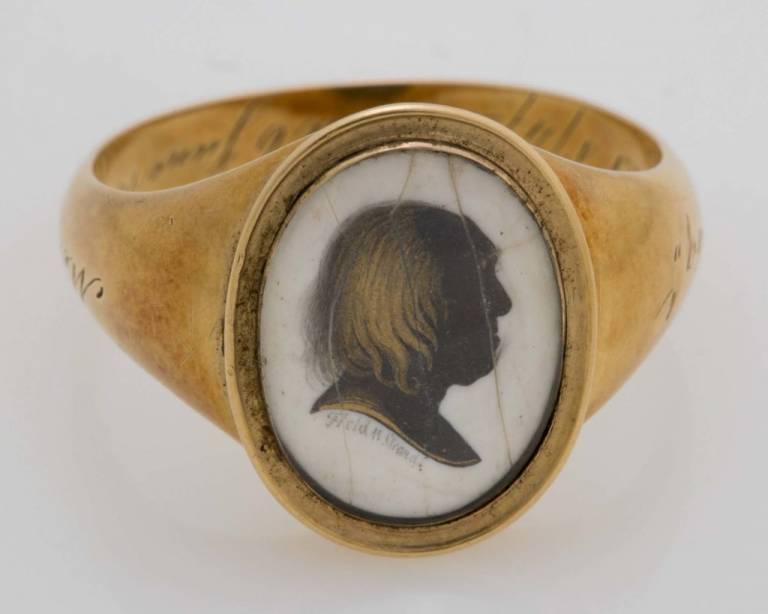Fellowship of the rings: Bentham's legacy
10 September 2018
The world-renowned English philosopher Jeremy Bentham (1748-1832), and the spiritual forebear of UCL, famously left his remains to science, but his head and strands of his hair are also the key feature of twenty-six memorial rings that he had made before his death.

Bentham, who first made preparations aged 21 for what should be done with his remains after his death, left in his final will and testament a list of the names of twenty-six individuals who were to receive a mourning ring.
Each memorial ring features Bentham's engraved signature and a silhouette bust of his head, and on the reverse is a glazed compartment containing his plaited hair.
The silhouette portraits of Bentham were created by the artist John Field, who at the time was working by appointment to William IV and Queen Adelaide.
It is believed that Field completed the silhouettes in no more than five minutes, due to his incredible skill at capturing a detailed likeness through the medium of portraiture.
"The mourning rings were probably commissioned by Bentham in 1822, when he had his silhouette painted by Field. We also know that on 2 November 1822 Bentham's secretary took some of his hair to Field and his partner John Miers for the rings," said Dr Tim Causer, UCL Bentham Project.
Among the twenty-six individuals named in Bentham's will is the editor and linguist Sarah Austin (1793-1867), whose husband, John Austin, was the first Professor of Jurisprudence at the University of London; the Guatemalan philosopher and politician José del Valle (1780-1834); and the French aristocrat and military commander the Marquis de Lafayette (1757-1834).
UCL holds four rings of those rings in its Museums collections. Three are known to have belonged to the publisher and bookseller William Tait (1793-1814), the Belgian politician Sylvain van de Weyer (1802-72), and the other great utilitarian philosopher John Stuart Mill (1806-73). The fourth ring has not been inscribed, so it remains unclear who it belonged to.
The ring belonging to Mill was purchased by two UCL alumni from a New Orleans jewellery shop, indicating how far and wide the rings may have travelled.
It is known that two other rings have been identified - one is in the possession of the descendants of William Stockwell, one of Bentham's servants, while a ring bequeathed to the French economist, Jean-Baptiste Say was recently sold at auction by Christie's. However, the whereabouts of the remaining twenty rings remain unknown.
"We can safely assume that José del Valle received one, as he is featured wearing it in a portrait (image to left). Interestingly, on the bookshelf of that portrait is one of Bentham's works as well as a Spanish translation of Say's Traité d'économie politique. It's a neat, tangible link between Bentham, Say, and del Valle."
The mourning rings were one of a number of arrangements made by Bentham to preserve his legacy He had willed that his corpse be publicly dissected as a statement of his belief in the utility of the dead body, and for the preservation of his remains as an 'auto-icon' which was to be available for display.
Subhadra Das, Curator at UCL Culture, said: "Bentham revolutionised our idea of what death is. When Bentham donated his body for the advancement of science it was considered a social taboo, but his ideas framed the Anatomy Act 1832 that allowed medical practitioners and students to dissect donated bodies.
"The memorial rings also help to highlight how attitudes to death and memory have changed over time. The rings and the lock of hair might seem morbid to some today, but it was fairly common practice at the time.
"Our modern, western views of death come from the early 20th Century when World War I made grief a luxury and the psychological theories of Sigmund Freud encouraged its repression. I think the Victorians would find our attitude to death rather cold."
UCL is home to the Bentham Project, virtually unparalleled in scope and importance as a humanities research project, which for almost sixty years has been engaged in the production of the new edition of The Collected Works of Jeremy Bentham, as well as illuminating and promoting the historical and contemporary significance of Bentham's thought.
The auto-icon - comprised of his skeleton, surmounted by a wax head, and dressed in a suit of Bentham's own clothes - was given to UCL in 1850. The auto-icon has just returned from a six month trip to the US to be part of an exhibition on life and death at the Met Bruer in New York. It is now back on display in the UCL cloisters.
Links
Image
Media contact
Natasha Downes
Tel: +44 (0)20 3108 3844
Email: n.downes@ucl.ac.uk
 Close
Close

